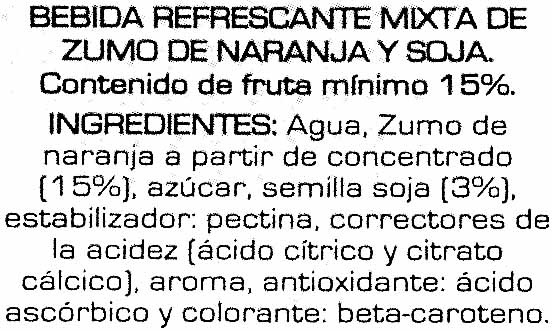Soja sabot naranja - Don Simón - 1 l
This product page is not complete. You can help to complete it by editing it and adding more data from the photos we have, or by taking more photos using the app for Android or iPhone/iPad. Thank you!
×
Barra-kodea: 8410261638003 (EAN / EAN-13)
Izen arrunta: Bebida mixta de zumo de naranja y soja
Kopurua: 1 l
Ontziratzea: Tetra Brik
Markak: Don Simón
Kategoriak: en:Plant-based foods and beverages, en:Beverages, en:Plant-based foods, en:Legumes and their products, en:Dairy substitutes, en:Milk substitutes, en:Plant-based beverages, en:Fruit-based beverages, en:Plant-based milk alternatives, en:Legume-based drinks, en:Fruit and plant-milk beverages, en:Soy-based drinks, en:Fruit and soy beverages, en:Orange-juice-and-soy-drinks
Etiketak, ziurtagiriak, sariak:
en:Vegetarian, en:Vegan, en:FSC
Manufacturing or processing places: Daimiel, Ciudad Real (provincia), Castilla-La Mancha, España
Traceability code: ES 21.18681/CR CE, J. GARCÍA CARRIÓN LA MANCHA S.A., J. GARCÍA CARRIÓN S.A.
Link to the product page on the official site of the producer: http://garciacarrion.es/es/donsimon/soja...
Matching with your preferences
Ingurumena
Carbon footprint
Ontziratzea
Transportation
Report a problem
Datuen iturria
Product added on by javichu
Last edit of product page on by moon-rabbit.
Produktuaren orria -gatik editatua autorotate-bot, kiliweb, maylord, musarana, neptuno, openfoodfacts-contributors, thaialagata, yuka.SFBvUE4vODlvTk1qbjlzUDdBdmIxNE5OMjhLV1dUaXhjdWdPSVE9PQ, yuka.sY2b0xO6T85zoF3NwEKvlh1Hc4byrw_KbgXhi3bb3_qCAqXpQIgs6ZjWPKg, yuka.sY2b0xO6T85zoF3NwEKvllF5U97aqx3JHCfll0ymnIaAcsLQPs1d2KT_N6g.










